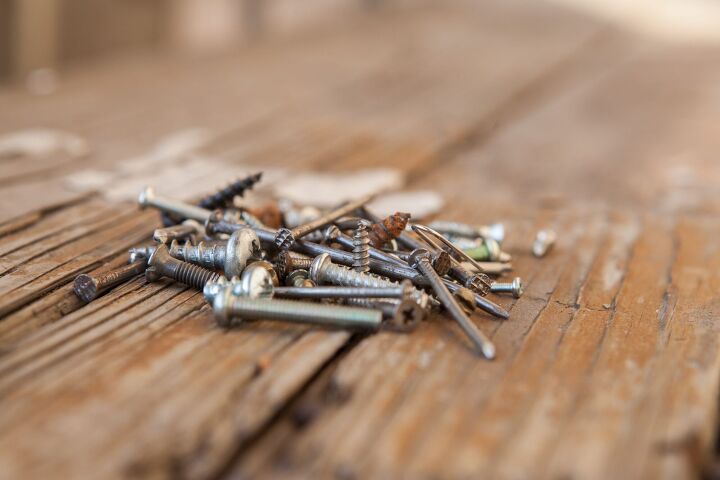Nails Vs. Screws: Which One Should You Use For Your Project?

Nails and screws are a mainstay in many construction projects. You would be hard-pressed to tackle any home improvement task that doesn’t call for one or the other. But how do you know when to use nails or screws for your project?
Screws are ideal for projects that require more holding power and strength, like installing cabinets or shelving. Nails work well when you need a more discreet look. Builders working on larger projects requiring a high number of fasteners (installing a roof) also prefer nails because of their cheaper price point. Nails also provide more shear strength.
If you’re not sure whether to grab the nails or screws for your next DIY home project, it’s best to know the benefits of each. After considering a few key points, you can make a more informed decision on which fastener is the best for your particular project.
What’s The Difference Between A Nail And A Screw?
Based on their appearance, you can already tell the difference between a nail and a screw. A screw has threads and various heads, like flat, Philips, star, torx, and hex.
Plus, they can be oval, rounded, indented, hexagonal, truss, and other shapes. Screws also come in many different materials, including brass, titanium, steel, stainless steel, aluminum, and copper.
Of course, nails come in various sizes and types as well, and some even have threads. But a nail typically has a flat, smooth head atop a thin spike. You can also find nails in a variety of materials, but the most common nails consist of steel or iron.
However, beyond their appearance, what’s the main difference between nails and screws? They’re both fasteners, but that doesn’t mean you can use them interchangeably.
Screws have extremely good holding power, especially in applications where they will need to bear a lot of weight. (Think of things like installing kitchen cabinets, shelving, sub-floors, etc.).
However, nails are cheaper, and ideal for projects when you need to move fast and use a lot of fasteners (think framing, roof installations). Nails are also great when you need the fastener to essentially disappear (trim and finishing work).
When Should You Use Screws For Home Improvement Projects?
In general, you should opt for screws if you’ll be placing a large load on your fasteners. Basically, think of it this way — nails will become loose and pull out faster than screws when you apply the same weight. Therefore, when you’re working with load-bearing projects, a screw is almost always going to be the better option.
1. Decking Projects
Screws give you more holding strength. Plus, there are several advances in technology that have led to different styles of screws that provide faster applications. There are even screw styles these days that give you the ability to hide the fasteners.
2. Sub-Flooring
Screws provide excellent joining strength, making them a good fit for sub-floors. They can help prevent squeaky floors, since they’ll keep things from shifting.
3. Cabinet Installs
When installing kitchen cabinets, screws are ideal, since your cabinets will bear a lot of weight. Screws make joints stronger, which is important when you’re working on something that needs a lot of holding power.
4. Weight-Bearing Furniture
Think about the underside of your chairs and tables. Most likely, the top attaches to the base or the legs with screws. Again, screws give you more load-bearing capabilities. Plus, in these areas, the screws are out of sight, so there’s no need to use subtle fasteners.
5. Temporary Projects
Another great thing about screws is they are easy to remove and reuse. Therefore, if you’re trying out something or you only need a temporary hold, use screws. For example, you need to install a board as temporary support for installing shelving or cabinets.
6. Installing Drywall Or Gypsum
Screws hold drywall in place better than nails (nails are more likely to pull out). Plus, most of the time, hammering nails into drywall can cause it to crumble. That’s why there are even specific screws for this job, aptly named drywall screws.
When Should You Use Nails For Home Improvement Projects?
Reach for nails when you’re working with projects that call for lots of fasteners or when you need a more flexible hold. Also, nails are a go-to when you want a more discreet look.
1. Exterior Projects
Many construction professionals prefer nails for exterior applications, including siding and roofing. These types of projects require a massive number of fasteners. Therefore, the lower price point of nails makes them a more appealing choice for these tasks.
2. Interior Finishes
When doing finishing work, such as installing trim, molding, and baseboards, nails are a better pick. They’re easy and fast to install and also won’t show as much as screws would.
Nails are also ideal for finishing carpentry and any other projects requiring a subtler, less visible fastener. They also won’t split wood as likely as screws. However, if the job you’re working on requires more strength or holding power, use trim screws. These types of screws have a smaller head than regular screws.
3. Framing Jobs And Large-Scale Projects
Nails are most often the fasteners of choice for framing projects and other large jobs since you can install them super fast with nail guns. Also, the lower price offers lots of appeal, especially with the higher costs of construction. It’s nice to save money wherever you can, as long as you’re not compromising on quality or safety.
There are pneumatic drivers that work with screws. These tools can make things easier if you decide to use screws or a combination of nails and screws in your project.
Why Do Construction Workers Prefer Nails?
Even though screws tend to provide a stronger hold, construction industry workers prefer nails for most tasks. There are three main reasons for this preference.
- Less expensive — An average 1,200-sq.-ft.-home can contain roughly 12,000 nails. Since nails are cheaper than screws, using them can save a significant amount of money.
- Easier to install — Overall, nails are faster to install than screws. Many screws require you to drill a pilot hole before installing the screw.
- Increased shear strength — Screws offer a stronger hold, but a nail delivers more shear strength. This means a nail holds up better when two objects slide past each other. This is what makes them such an ideal choice for exterior projects that expose wood to various elements that make it expand, contract, or shift.
Questions To Ask When Choosing A Nail Or A Screw
When determining if you should use a nail or a screw for a project, there are a few questions to ask yourself.
- What type of stress or pressure will the fastener be exposed to?
- How big is the project?
- How fast do you need to complete your project?
- Are you working on a temporary structure or a permanent installation?
- What tools do you have available for installing the fasteners?
- How much budget do you have for the project?
- What material are the fasteners going into?
- Is it okay if the fasteners are visible, or do you need them to be less noticeable?
1. Pressure On The Fastener
Consider how much pressure and what kind of pressure will be on your fasteners. If the project needs to bear a lot of weight but won’t move side to side (think shelving), screws provide excellent strength. As weight bears down on the shelf, a screw will provide more tensile strength.
This tensile strength comes from the threads helping the screw hold firm. In contrast, as the same weight bears down on a nail, the nail will eventually loosen and pull out of the structure.
But nails offer more shear strength. Therefore, if the project involves materials that will move side to side, nails provide more durability. (For example, your house reacting to heavy winds.) The actual nail is stronger, and when pieces of wood slide against each other, the nails may bend but won’t break.
2. Project Scope
If it’s a large-scale project that needs to be done quickly, nails win. Likewise, if you need to stay on a reasonable budget and are working on a big project, nails will be the better choice.
3. The Project Details
Is your project a temporary one? Then screws can work better if you plan to remove them soon. Just reverse your drill and remove the screw.
Also, consider what materials and tools you’re using. If you’re working with drywall, for example, you need drywall screws. If you’re installing trim work and have a nail gun, then nails are an obvious choice.
Make sure to consider every angle of your project to make the best choice of which fasteners to use.
Nails Or Screws?
For most home improvement projects, you’ll likely find you need screws and nails. But answering a few questions can help you decide which fastener to use and when. The most significant consideration is to understand the type of pressure on the fastener. If it’s something that needs to bear a lot of weight, screws provide better holding power.
Alternatively, nails offer more shear strength, are faster to install, and cheaper than screws. Therefore, they’re a top pick for large-scale construction projects. Nails also work well when you want your fasteners less visible.
Think about your materials, tools, and the scope of your project when choosing your fasteners. If you’re still uncertain whether to use nails or screws, consult a professional about your project.
Purchasing high-quality fasteners from a reputable home improvement store is a great first step, since knowledgeable staff can help answer your questions about your specific project.
Related Guides:

Stacy Randall is a wife, mother, and freelance writer from NOLA that has always had a love for DIY projects, home organization, and making spaces beautiful. Together with her husband, she has been spending the last several years lovingly renovating her grandparent's former home, making it their own and learning a lot about life along the way.
More by Stacy Randall



























